-
THE LAST OF THEIR KIND
Joachim SchmeisserMarch 1st - April 25th, 2021
-
Please click on images to view the different formats available as well as to see the artwork framed and "on the wall" in its medium size.
Prices are avalaible on request by clicking on "Enquiry" or directly by email at: info@echofinearts.com
A percentage of each fine art print sale will be donated to the Sheldrick Wildlife Foundation in order to "Sponsor an Orphan".
-
" What interests me is what lies beneath the surface, out of sight, the quiet yet intense encounters. I'd like you to see my images as a window into this fascinating world, one that is the same as our own yet so very unfamiliar. They are intended to raise awareness of the beauty and limitless diversity of our natural world, where everything is connected to everything else. Protecting nature is our most important mission."
- Joachim Schmeisser
-

-
For years, Joachim Schmeisser has been photographing the last giants of Africa at close range, creating exceptionally intimate portraits of species threatened with extinction.
In his series "The Last Of Their Kind" he focuses on the beauty of creation and its fragile transience. These striking images are timeless works that can be interpreted on different levels: as depictions of a distant past or as iconic memories in a not too distant future in which we can only admire these majestic creatures in zoos. They are both an homage and a final warning - visual revelations that sharpen our clouded view of nature in all its infinite complexity as well as recognizing what treasures we might irretrievably lose.
Born in Germany in 1958, Joachim Schmeisser is best known for his major photographic series he has done in East Africa – his iconic portraiture of Elephants – especially the Orphan Elephants at the Sheldrick Wildlife Trust in Kenya.
He started this project in 2009 and it is still ongoing even today and has become a matter close to his heart. In 2012, Joachim Schmeisser won the prestigious Hasselblad Award for this work. In 2017 his book "Elephants in Heaven" was launched by the German Publisher teNeues and sold out within 4 months.
His following book, Hall of Giants shows a selection of large-format portraits of some of the oldest and largest bull elephants in Africa as well as young elephants that have the potential to grow into Big Tuskers. All of the photographs were taken with medium-format cameras without the use of remote control devices or long lenses. These close-ups are extremely rare in the genre of wildlife photography. Of the Big Tuskers in Amboseli, they are the only ones that exist in this form.
His upcoming release, which is entitled The Last Of Their Kind, will be published in Spring 2021 by teNeues.
-

Rise
2019 -
"In January 2019 I photographed the Rhinos at the foot of Mount Kenya. This special place is home to one of the largest populations of rhinos in Africa. The white rhino recovered from near extinction with numbers as low as 50 – 100 left in the wild in the early 1900’s, this sub-species of rhino has now increased to approx. 20,000, with the vast majority living in a single country, South Africa.
I moved in very close, to capture the authentic spirit and graceful beauty of these tremendous animals. Being so extremely near to this magnificent Rhino bull when he rose, I had the feeling the dinosaurs never died out and fortunately some of them still roam the Earth."Joachim Schmeisser
-

-

Lionheart, 2020
-
Lions are the most sociable of all big cats; They live in groups called prides, which usually consist of related females and their cubs. Dominant males, with their flowing manes (a sign of virility), fight to maintain breeding rights. Powerful and majestic, the king of the beasts has no natural predators. But unthinkably, African lion numbers have plummeted by over 40% in the last three generations, due to loss of living space and conflict with people. Yet three-quarters of African lion populations are in decline. With only around 20,000 in the wild, they're now officially classified as 'vulnerable'.
Source: wwwf.org.uk
-

The Lioness, 2020
-

Giraffe in Front of Mount Kenya
2019 -
-

-

The Divine
2020 -

Tomorrow's Leader
2019 -
Behind the Scenes
Part I -

Preserver of Peace, 2019
"I shot this picture only 2 meters away from Tim, the gentle Giant in Kenya.
During my work over more than 10 years, there have been many exciting and wonderful encounters, but this was truly a once in a lifetime moment. His tusks were up to 3 meters long and weighed together over 140kg. Tim was one of the last remaining super Tuskers in Africa. But he was not only famous because of his majestic tusks, also for his unassuming, unpretentious and laid back character. That's why he was the darling to tourists and female elephants with their families.
He was an ambassador for his species and an irreplaceable symbol of our unique natural heritage. Tim died at 50 years old on the 5th February 2019 from natural causes. I will never forget this irretrievable moment in my live and I'm so glad to had the chance to meet this legendary elephant."-Joachim Schmeisser
-
-
"Most of my pictures could have been made thousand years ago. And there are moments in Africa you feel like being part of a time Machine. Capturing one of these moments not only makes you happy, but the miracle of photography is to be able to preserve the fraction of a moment and create a window to another universe."
-Joachim Schmeisser
-

Beyond II
2019
Join our mailing list
* denotes required fields
We will process the personal data you have supplied in accordance with our privacy policy (available on request). You can unsubscribe or change your preferences at any time by clicking the link in our emails.






















